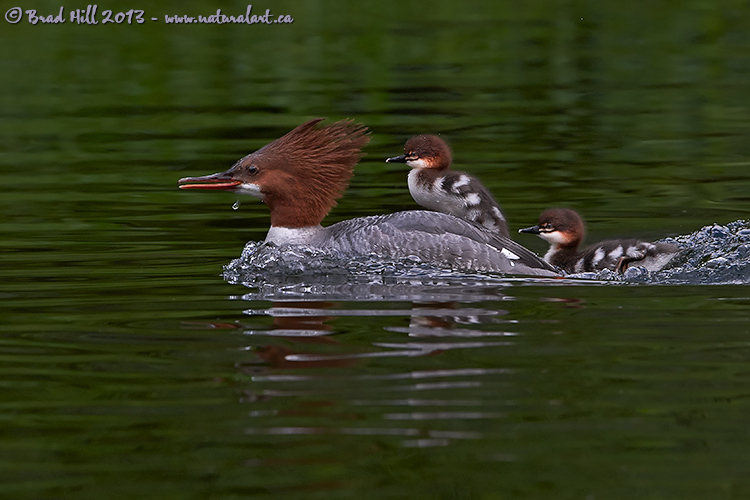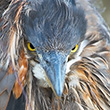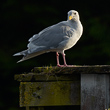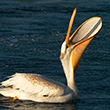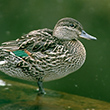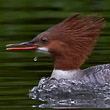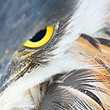Availability: Undetermined - Enquiries?
In the Field
The Hitchhiker. Khutzeymateen Grizzly Sanctuary, Great Bear Rainforest (northern BC coast). May 31, 2013.
This shot definitely qualifies as a quick grab shot - it was one of those situations where the time from seeing the subject and scene through to it being all over lasted maybe 3 seconds. At the time we were cruising through the interconnected web of channels found in the estuary of the Khutzeymateen Grizzly sanctuary. As we turned a corner we almost bumped into a female Common Merganser that had two chicks with her. Ma instantly started motoring through the water at real high speed (note both her wind-swept hairdo and the standing wave in front of her!) - and her two chicks struggled to climb up on her back. Only one made it, but the second was old enough to have the speed to stay in her wake (or slipstream) and JUST keep up (but it really struggled to do so).
Even though this was an unexpected grab shot and the encounter was a bit on the random and "lucky" side, the reason I was able to capture the shot had little to do with luck. Our modern DSLR's have an almost dizzying array of options and functions. And, there are things on them that they can do (or things we can customize) that most of us can live without. In my case anything to do with video can be safely ignored! But...something I DON'T ignore is setting up and configuring my camera's Shooting Banks. I won't get into the nuts and bolts right here of how I have set them up, but one of my Shooting Banks is set up for capturing action (aperture priority, Auto ISO with minimum shutter speed of 1/1600s, etc.). And, I have customized the "Function" button on my D4 so that I can switch between shooting banks simply by pushing that button and toggling the main command dial. So...in this case...even though I had little more than a second or two to react, I was able to switch from my "normal" shooting bank to my Action shooting bank, adjust aperture (stopping way down for depth of field to get all 3 subjects in focus) and exposure compensation (major under-exposure from matrix-metered exposure "recommendation" to preserve white highlights on the subjects) and capture the shot as you see it. Without having my shooting banks configured this way odds are this shot would have been missed (or little more than a blurry mess). Lucky encounter? Yes. Lucky to get the shot? Nope.
Moral of the story? If you're into wildlife shooting, you should know your camera well enough to understand what settings and functions you can safely ignore. And, if your camera supports setting up configurable Shooting Banks, User Settings, or Custom Settings, you might want to put some thought into how you can configure them to ensure that you'll miss fewer of those "gone-in-an-instant" shots that we all encounter from time-to-time.
NOTE: This image was captured during one of my "Grizzlies of the Khutzeymateen" photo tours in the spring of 2013. Each year I offer trips into two different parts of the Great Bear Rainforest. Each spring we visit the northern portion of the Great Bear Rainforest during my two "Grizzlies of the Khutzeymateen" photo tours. And each autumn we travel through the heart of the Great Bear Rainforest during my two 7-day "Into the Great Bear Rainforest" photo tours. Details about these trips can be found on the Photo Tours page of this website.
Behind the Camera
The Hitchhiker. Khutzeymateen Grizzly Sanctuary, Great Bear Rainforest (northern BC coast). May 31, 2013.
Digital Capture; Compressed RAW (NEF) 14-bit format; ISO 4000.
Nikon D4 paired with Nikkor 600mm f4 VR lens. Hand-held from floating Zodiac. VR on and in normal mode.
1/1600s @ f10; -1.67 stop compensation from matrix-metered exposure setting.
At the Computer
The Hitchhiker. Khutzeymateen Grizzly Sanctuary, Great Bear Rainforest (northern BC coast). May 31, 2013.
RAW Conversion to 16-bit TIFF, including first-pass/capture sharpening using Capture One Pro version 7. Two raw variants (images processed from raw) differing by a total of 0.6 stops in total exposure.
Further digital corrections on resulting 16-bit TIFF files using Adobe's Photoshop CS6. Photoshop adjustments included compositing/blending of the two exposure variants, very minor colour tweaks (hue rotation and desaturation of selected colours), further selective exposure tweaks and selective contrast adjustment, and selective sharpening for web output.
Conservation
The Hitchhiker. Khutzeymateen Grizzly Sanctuary, Great Bear Rainforest (northern BC coast). May 31, 2013.
Ten percent of the revenue generated by this image will be donated to Raincoast*.
Species Status in Canada**: Not considered at risk.
The Common Merganser (Mergus merganser) is reasonably large cold-adapted species of duck that nests around the northern part of the globe near lakes and rivers in forested habitats. They are fish-eaters and, being near the top of the food chain, serve well as environmental indicators of both contaminants and lake acidification.
Although there is no reliable continent-wide estimate of the current population size (or population trends) of Common Mergansers in North America, most local population trends suggest that the North American population size is liikely stable or increasing. In some areas this merganser has been the victim of eradication programs, largely owing to the belief that they may have threatened salmon or trout stocks. Most of these eradication programs took place in the early and mid-20th century and have since been discontinued. Common Mergansers are not a prized game species so direct human actions are not currently thought to be negatively impacting on their population sizes.
The region this image was shot in is, at the time of this writing (August 6, 2013), facing a new and potentially catastrophic threat. There is a proposal to bring oil super-tankers through the narrow and treacherous channels of the Great Bear Rainforest. Any mishap - such as the one that sunk the Queen of the North ferry on March 22, 2006 - could result in an oilspill with disasterous consequences.
*The Raincoast Conservation Society (and Foundation) is an effective and efficient organization that has been fighting for protection of this unique habitat. If you are looking for a meaningful way to contribute to the conservation of this amazing ecosystem, Raincoast will provide maximal "bang" for your conservation dollars.
**as determined by COSEWIC: The Committee on the Status of Endangered Wildlife in Canada













